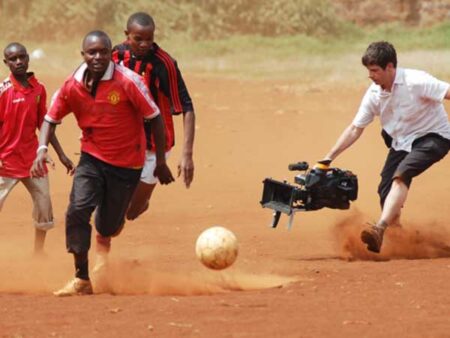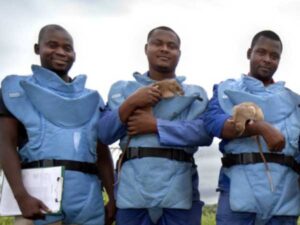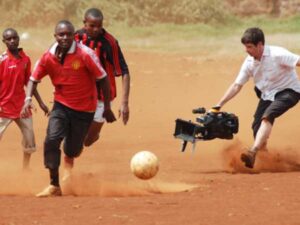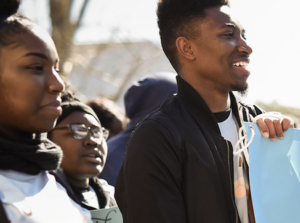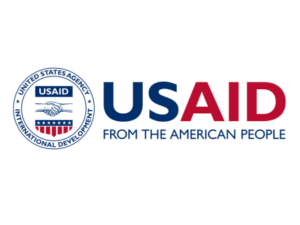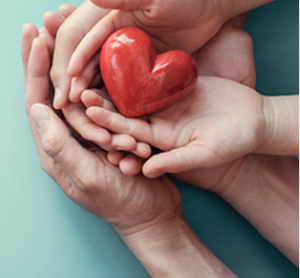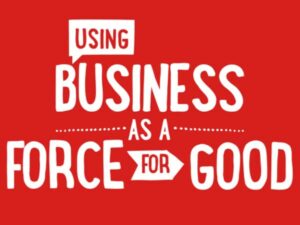Search for Common Ground is a peacebuilding organization with the majority of its staff working in their home countries to end violent conflict.
Shamil Idriss of Search for Common Ground spoke with Ashley Hopkinson on January 25, 2024. Click here to read the full conversation with insights highlighted.
Ashley Hopkinson: What would you say is the reason Search for Common Ground is here? What is the problem it’s trying to solve?
Shamil Idriss: We exist to address what we see as a principle issue that affects everything else, which is the challenge of dealing constructively with conflict. We see more and more of the world’s problems requiring collaboration if they’re going to be solved: collaboration between countries, cultures, generations, genders. The win-or-lose approach to problem solving in a world that’s so interconnected only yields more losses. So the way that we go about our stated mission is to transform the way the world deals with conflict away from an adversarial win-or-lose approach towards collaborative problem solving.
At the root of that is how we think about conflict: it isn’t a good or a bad thing, it’s a natural thing. It’s like friction. If you handle friction well, it’s one of the most valuable forces in the world. You can create a fire, cook your food, build buildings, do all kinds of things if you manage it well. If you manage friction badly, you can destroy everything.
Conflict is very much the same way: the more diverse and interconnected your community, the more friction you’re going to have. If you build trust between people, get people facing common problems together, and bring all of the diverse perspectives to shared problem solving, you get much more creative and durable solutions. But if you don’t build that trust, you get polarization, and at worst violence, which destroys everything. So that is what we exist to address.
We start with a ‘multi-partial stance,’ which is a lot of syllables, but it distinguishes us from a ‘neutral’ or ‘impartial’ stance, because we’re not third-party arbitrators or mediators. Our teams are not only local to communities in conflict, but crucially, they are drawn from across those conflict dividing lines. So if you’re trying to tackle any issue, say, the often antagonistic relationship between police and young people, it helps if your team that’s strategizing and mobilizing is made up of retired police, youth activists, former gang members, and everything in between. And instead of sitting across from each other at the table, seeing each other as the problem, they’re on the same side of the table facing a common problem.
The first major advantage of this approach is that there’s real humanity to it. You are of the community. You’re not intellectualizing things or talking about them from a distance. Your community is directly affected by what’s going on. The second is credibility. When you have a team that has representation from across dividing lines, collectively, they have a unique credibility and convening power. There are some places — our Hutu Tutsi team in Burundi, our Sinhalese and Tamil team in Sri Lanka, our Israeli-Palestinian team in the Middle East — where these teams are the only ones trusted to convene around certain conversations. A team like this not only understands the power dynamics, injustices, and imbalances at play, but because they represent the dividing lines, they recognize that injustice affects everybody. It traps and limits everyone. It doesn’t mean that everyone suffers equally, but all the great justice advocates and peacebuilding leaders, from Mandela to Gandhi to King, understood that what we’re trying to do here is not just flip the tables but arrive at a higher place where everyone has dignity. There’s a lot of authenticity in these teams, because the means and the ends are totally aligned. We’re not going to create a more inclusive world through an adversarial, you-versus-me approach.
We also see a real push towards action with our teams. Dialogue is always necessary, but it’s never sufficient. You have to translate that dialogue into cooperative action that starts to address people’s real concerns and interests and needs. Otherwise people get cynical about dialogue.
So we have a multi-partial team that is both local and made up of people from across dividing lines. And once we’ve got a team like that, we apply the Common Ground Approach, which broadly is an approach to driving change that doesn’t drive a wedge between people. There’s three steps to this approach, which we call trust, collaboration, and breakthroughs.
Trust is about figuring out what will bring people together in a conflict-free way. A lot of times, especially in divided societies or where violence or tension is prevalent, trust building starts with engaging in arts, culture, or sports — anything that will get people sitting together. I don’t know how many soccer tournaments we’ve organized because it’s the only thing that will bring certain groups together. Our teams also do community theater performances, that in the past have brought military personnel together with members of the community that they’ve been abusing to watch a dramatic performance, then open up a discussion afterwards.
The critical next step is collaboration. Peace is built at the speed of trust, and the best way to build that trust is through collaboration. And you can’t fast track it. People have to learn that they can benefit from working together, so our teams support divided communities to cooperate on shared problems. It’s less about what the specific issue is as long as the community members and stakeholders want it done. Maybe they want to cooperate around water access, or maybe there aren’t enough street lamps around the school and kids feel unsafe walking home in the evening. So enough trust is built such that people can identify common interests or concerns, and then we help people cooperate to address them.
Those first two steps can go on for years. The more collaboration you get, the deeper the trust. The deeper the trust, the more you can move from soccer tournaments and community theater performances to actual cooperative action that is getting to the root of some of the conflict. And when it works, it leads to the third and final step, which is breakthroughs towards peace.
Ashley Hopkinson: What makes Search for Common Ground distinctive amongst other organizations that are in the business of prioritizing peace?
Shamil Idriss: Being multi-partial means there’s a lot of localization and proximity in our work. But that’s only half of the story. We’re interested in fostering inclusion and understanding across dividing lines. People are quick to want to act as mediators in an adversarial approach, and a lot of people come to us and ask us about how we deal with polarization. But polarization is rarely the cause of the issue. It’s one of the symptoms, it’s like a fever. If you have a patient who comes to you as a doctor and they’re sick with a fever, you’ll help bring the fever under control, but the conditions which caused the fever are the real issues you need to understand.
Ultimately, a lot of this polarization is the result of an over-investment in adversarial approaches to issues that are much more complex than ‘the good’s over here and the bad’s over there.’ So what sets us apart is that our teams are both local and drawn from across dividing lines. Secondly, our methodology is based on building peace through commitment to cooperative action: transforming relationships by having people work together. And lastly, over our 42 years of experience on the front lines of challenging conflicts, we’ve learned not only what works, but how to measure our impact.
Over the last couple of years, our teams queried not only the communities where we work, but also a couple hundred peer organizations, policy makers, and funders around what they think impact looks like. We’ve generated a framework which we call the Peace Impact Framework, and made it available for governments, peer organizations, and even the UN to utilize. It’s like when the medical field went from treating disease to preventing disease, and a big part of that was promoting a healthy lifestyle. But to promote a healthy lifestyle, doctors needed to identify the vital signs that we should be testing for, the healthy range of those signs. If you go to a doctor anywhere in the world, the first thing they’re going to do is take the same few vital signs. Your temperature, pulse, heart rate, pain level, all that stuff. We’ve made an equivalent for identifying the vital signs of a healthy society, a guide map for what to look at when trying to diagnose community conflict. Much like understanding how your body will respond when it comes into contact with a virus, we want to know whether a community will rally and overcome conflict, or if it will fall apart into polarization and violence.
We identified five vital signs to consider. The first is inter-communal trust between members of different groups. The second is institutional legitimacy, whether people trust the institutions that govern and serve them. The third is levels of violence. The fourth is a sense of personal agency to affect change in one’s own life and make a difference in the future. And fifth is resources, understanding what is being prioritized in the budget and what is ignored.
Ashley Hopkinson: How do you get people to understand that these vital signs you’re looking at really are vital?
Shamil Idriss: One of the things that we’ve found is that every society has all kinds of assets and champions, even in seemingly retrograde or authoritarian systems. So when we engage with any community, we use an appreciative inquiry model. And one of the primary findings of this model is that the worst way to change behavior is to punish bad behavior.
The best way to change behavior is to identify, amplify, incentivize, and celebrate every step towards the desired behavior, no matter how tiny it might be. So when we go into any conflict setting or any community in crisis, we don’t spend a lot of time asking questions about what’s going wrong or what the biggest problem is, because in any setting where you ask those questions, it feels like everything’s gone wrong. Instead, we ask questions like, if this is a racial divide or an ethnic divide, “Is there anyone across races or ethnicities that you respect or that you trust?” If it’s a corrupt government, “Is there one official who you feel like is trying to serve the people?” If it’s an out of control police force, “Is there a captain or even a beat cop who people in the community feel like they can work with?” And what we’ve found one hundred percent of the time, in even the most supposedly hopeless situations, is that we get tons of names. People appreciate being asked these questions rather than being asked what’s wrong with their community. So through this lens, we identify the people who are already the champions and the engines of their community, the people who have constituencies.
We’re also transparent about where we find the data for those five indicators. There are three primary inputs for this information: firstly, there’s a UN office that tracks levels of physical violence in every country of the world that we use. The second comes from experts. We ask peace-building leaders and people who are bridging divides in communities how things are going. And the third and maybe most important source is community members. We ask what progress or success would look like for them. We don’t impose a framework, we ask them to define their own success.
Ashley Hopkinson: Could you think of an example of a story of impact that you feel like illustrates the work you’re doing?
Shamil Idriss: I think of the work our Kenya teams are doing — they’re spread across different regions, but they’re all led by this extraordinary woman named Judy Kimamo. Judy used to work for Wangari Maathai, the noble laureate, for her environmental group in Kenya. Judy was actually taken hostage, and she literally negotiated her own release. Afterwards, she decided to devote the rest of her life to peace building, to reaching out across the divides of these different communities, including to the young men that she had been taken by. In Kenya there have been violent attacks from non-state groups, in this case, al-Shabaab. And as is often the case in the countries where we work, the government’s response is far too heavy-handed. They come down on everybody because they don’t know who’s a member of one of these groups and who’s a citizen just caught up in this.
The government learned that some of these al-Shabaab attackers had infiltrated the country from the shores by posing as fishermen, particularly overnight, so they completely banned night fishing. This destroyed the economy along the entire coastline, and it fueled lots of resentment and anger. There were clashes between people in these communities and the police. Judy was looking at this with members of our team who are well plugged in across Kenyan communities.
So Judy and the team started shuttling around to the fishermen’s collective, to the various security agencies, to the youth groups, and to the human rights organizations, all of whom were putting their money into either organizing demonstrations or preparing legal action against the government. And little by little, she was able to get all these community members to put some of their resources into a parallel process of beginning to meet all together, to see if we can come up with a solution that will benefit everybody. Together, they came up with an idea of issuing these electronic scan cards, called Mvuvi cards. So if you’re a fisherman and you’re registered, you get a Mvuvi card, and all the police along the shore will have scanners which will tell them whether you’re a fisherman or not, and then they won’t bother you. And after six years, they were able to reopen night fishing. I honestly feel like the economy of coastal Kenya was revived by one woman and her team, not putting themselves at the center, but gaining enough trust to get all the major stakeholders sitting together. And then building that trust by getting them to cooperate on ideas, and eventually they get a breakthrough that addresses the core issue.
Ashley Hopkinson: When you’re in the business of scaffolding and peacekeeping, and the endpoint isn’t always clear, how as an organization do you measure your success? How do you know when you’re progressing?
Shamil Idriss: There are two levels of measurement. There’s the one we talked about, which is identifying the vital signs and trying to move those vital signs in a positive direction. But the real win is when peace is manifested and sustained at scale. In our experience that happens when we see one or more of these indicators: there’s either a change in institutions, social norms, or market forces. Oftentimes we see a change in all three of them. And the common thing across all of those indicators is when they happen, that shift is going to sustain and even grow itself without relying on external funding or intervention. And when that happens, we’re no longer necessary. In the last five years, we’ve either spun out into purely local civil society organizations, or shut down completely, in 10 countries. A few that come to mind are Sierra Leone, Liberia, Tunisia, Macedonia, and Madagascar. These are places that were contending with civil war and no longer are, places where our teams played a central role in that transition away from violence. So we measure day-to-day success by those five vital sign indicators, but we measure real success by that systemic change where there’s been a change in institutions and social norms.
I can tell you one story from the DRC [Democratic Republic of the Congo]. This isn’t a country-wide success, we’re still doing work in the DRC. But 12 years ago, the rates of sexual assault were very high, and over 50% of those assaults were committed by people in uniform, military soldiers or police, abusing the populations they’re supposed to be protecting. Our Congolese team began to walk through the three-step process of trust, collaboration, and breakthroughs: they did soccer tournaments, they did community theater performances. They went into communities to find out what was going on with the police and turned these findings into dramatic, engaging plays. They would bring people into town squares, sitting military soldiers next to religious leaders for the performances, and then use these shows to open a conversation.
So they used all kinds of tools to initiate dialogue. They then moved into collaboration. There were women’s associations that were organizing demonstrations against sexual assault, and for the first time, men in uniform joined these demonstrations. It was shocking to people. It was symbolic, but it was important more substantively. In some districts, our teams facilitated conversations with police captains who would work with the local communities to develop scorecards, asking, “What would improved relationships look like to you?” And people would say, “If I have to go to the police station, I want a place to sit that’s not in the sun.” And the scorecards would be completed by community members on a quarterly basis. So there was this cooperation that further deepened the trust.
The breakthrough came when the training that had developed out of this program, a human rights training focused on women’s rights in particular, became a mandatory part of orientation both for police and for those in the military. And it’s evolved to the point where our team, which originally provided the training, is no longer involved at all. That training is now provided by senior members of both of the security forces, and levels of sexual assault have decreased significantly. That doesn’t mean that this is now a paragon of good police-citizen relations, but compared to where it was, there’s been a huge shift.
So what we try to do to measure our success is observe those shifts in institutions or social norms or markets, and then decide whether our engagement is needed anymore. In eight of the ten countries we pulled out of, our teams became local civil society organizations that are taking all of that accumulated knowledge and experience and continuing to do the work.
Ashley Hopkinson: Is there something that you’ve tried that hasn’t worked? What lessons did you learn from that?
Shamil Idriss: We do these ‘fail fairs,’ where we tell stories about massive failures and how our teams learned from them. When we started doing work in the Middle East decades ago, we took a model from the Organization for Security and Cooperation in Europe. The basic idea of this model was how to stop another war from breaking out on the European continent that then engulfs the whole world. We implemented that model in the Middle East, where we brought together high-level professionals and activists from many different countries: Israelis, Turks, Iranians, people from all over the Arab world, and sorted them into working groups based on their profession. The Israeli-Jordanian peace accord actually includes language that word-for-word came from one of these groups, but ultimately, there were too many top-ranking officials there for the exercise to be effective. We’ve learned over the years that peace cannot be driven purely top-down or bottom-up. It has to be both. That’s what makes our multi-partial teams so foundational for the work we do.
We’ve grown better at building multi-partial teams in high-conflict settings, but it’s not just about finding people who are willing to hang out with each other. It’s finding people who are actually respected in their communities. Right now with Israel and Palestine, if we’re ever going to get to peace, it will have to be delivered by staunch Zionists and staunch Palestinian nationalists. It’s not going to be by people who are always willing to meet with each other.
And while we’ve done a good job of building these teams, we don’t always have that combination of community level credibility with the political influence and access that we need. And you have to have both. The Middle East work that we were doing was purely top down, and there wasn’t a popular constituency for what was being built. And in places where it’s been all community level work but there isn’t any political will, it’s not going to lead to lasting change.
Another challenge we encounter is that our mission is fundamentally transformative, but the way that change happens will always be incremental. It’s like an iceberg caving in after years of slowly melting. It can take years, sometimes a generation, to arrive at those breakthrough moments. But the way that we’re funded is through very staid institutions. Most of our funding comes from nine different UN agencies who can be quite risk averse. And the best peace-building is relentless, highly adaptive, and risk-taking, identifying and seizing opportunities where they appear. We’ve been fortunate to grow through that largely institutional funding base, but if you’re going to drive transformational change, you need to be able to communicate it to people in a way that inspires them to action. So we legally acquired another organization in 2023 specifically because they had more sophisticated communications marketing and human-centered storytelling. Because one of the biggest barriers to peace-building is that people don’t even think it’s possible.
Ashley Hopkinson: What other challenges are you facing outside of funding? Is it issues of scale, public perception, political circumstances?
Shamil Idriss: I think it’s political imagination. People are bombarded with content and information on social media by things that make them believe that it’s hopeless, we’re doomed, and violence is part of human nature. It is not. Conflict is inevitable, but violence is not.
But it’s difficult for people to even conceive of what peace building looks like or what it means. A lot of people who think they know it have a very outdated notion that it’s holding hands and singing songs, that it’s nice when you can afford it but not relevant for the real world, but this is hardcore work. So a huge challenge is the lack of people who can imagine a future where we disagree but still feel united as a community and as a country. More and more people are starting to wonder whether they even want to imagine that future, if they want to live with these people they disagree with.
People don’t know that you can drive change across dividing lines without driving a wedge in society. There are win-win solutions. The more we tell stories like that, the more examples people see of peace building work being done across the world, the more I think people will be able to imagine it for themselves. We’re only just starting to tell these stories now, and people are jazzed when they hear them.
Ashley Hopkinson: How do you see your work evolving over the next five years?
Shamil Idriss: I’d like to see the emergence of more leaders doing similar work to us, more leadership development trainings that center collaborative change. I’d love to see college campuses where there’s not just the young Republicans and young Democrats, but there are people who are trying to drive change across Republican and Democratic lines. What we’re working towards is a much more dynamic force than just facilitating compromise. There are plenty of studies showing that the most effective teams are diverse ones, but these studies ignore the fact that the least effective teams are also diverse. The critical difference is when you take the time to build trust between members of these teams. You can build trust pretty quickly in a non-diverse team: they can always perform, acting on their similarities. But if you take the time to build trust across diversity, that’s when you get transformative change, that’s when you get creative, sustainable solutions.
We’re trying to develop a Common Ground Academy. We’re just designing this now to support our own promising leaders. I think of it almost like a martial arts academy, because there are so many different levels to this, and I believe that change-making is something to be celebrated, invested in, and trained for. And I’d like to see our organization eventually moving from supporting our own people to offering that leadership support and training outside of the organization.
Ashley Hopkinson: What do you think is the greatest thing your organization has done to advance systems-level change, and what is needed from other partners to support that work?
Shamil Idriss: I think the biggest contribution that we’ve made and we continue to make is relentlessly peace-building and fostering cooperation across dividing lines. Every time there’s a new challenge to our work, like with social media, our teams are on the front lines of trying to understand how we also use it to our advantage. So our biggest contribution is frontline, local and multi-partial innovation.
What I’d like to see from others is a recognition of the centrality of conflict to everything else. If you’re doing humanitarian work without taking into account conflict dynamics of the area you’re working within, you can actually have a really negative impact. After the Rwandan genocide, there was a shift in the humanitarian sector, and conflict sensitivity became mandatory. Every humanitarian organization now has to apply a conflict lens. And some of them are proactively contributing to peace with how they deliver humanitarian aid. Every movement activist, every funder of activism, needs to be asking the same question, applying the same conflict lens.
A lot of Americans and Europeans are starting to realize that we’re not as stable as we thought we were. And if we don’t deal with conflict dynamics, we might collapse. And even people who’ve been on the front lines of advocating for change are starting to think maybe the way we’re advocating is not delivering what we need. I’d like people to pay more attention to those five vital signs of a healthy society and deciding not to fund or participate in any action that pushes those indicators down, that makes people trust institutions less, that drives distrust between communities, that increases the levels of violence, or that reduces people’s sense of agency.
Ashley Hopkinson: You’ve been in this work for a while. What would you say is your greatest insight? Teachable lesson?
Shamil Idriss: I was so inspired by the words of Sister Helen Prejean, a Catholic nun and arguably the leading anti-death penalty advocate in the whole country. We had the opportunity to work with the Metropolitan Opera on a show called Dead Man Walking, and she came to see it. After the show, I moderated a talkback on stage with her. And in response to a question about hopelessness and futility, she said, “Look, just do one thing. I don’t care if you write a letter to a man on death row. I don’t care if you make a call to your congressman, I don’t care if you reach out to someone who was a victim of violence. Just do one thing. Because if you’re standing on the sidelines watching all these horrors going on, you become hopeless.”
She went on, “The minute you do one thing, you don’t realize the energy that you release into the world, even if it’s a very small thing. You inflame hope in yourself and in others, and you have no idea how that flame will build from there. But the act of doing something is everything, and overcoming that inertia of just observing is an act in itself.”
So I’m taking her words because they fit, and I believe her. I think all big changes start this way. There was no way that when Judy started meeting with human rights activists she could have imagined that within a year, the ban on night fishing would be lifted and the economy would be revived. There was no way she could have envisioned all of that, so she just started by doing one thing. She started meeting with people, and her team members started asking people questions. So that would be my biggest insight, is just do one thing. That, and the fact that conflict is inevitable, but violence is not.
Click here to read the full conversation with insights highlighted.
Ashley Hopkinson is an award-winning journalist, newsroom entrepreneur and leader dedicated to excellent storytelling and mission-driven media. She currently manages the Solutions Insights Lab, an initiative of the Solutions Journalism Network. She is based in New Orleans, Louisiana.
* This interview has been edited and condensed.
Learn about other peacebuilding social innovation insights.

